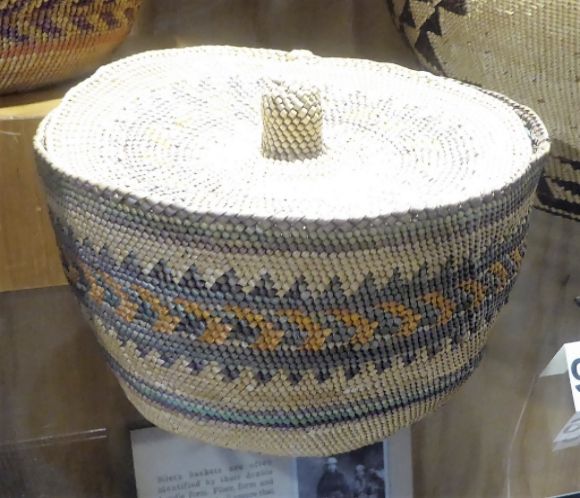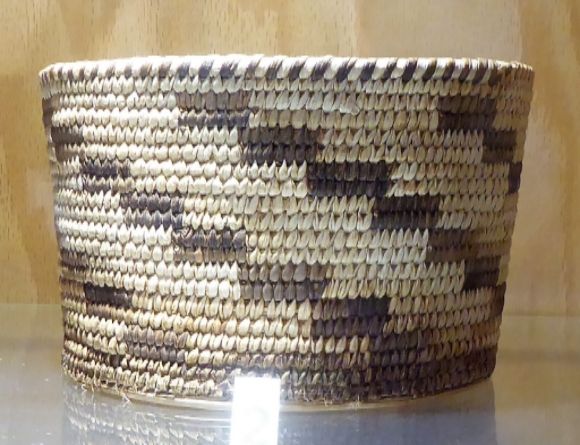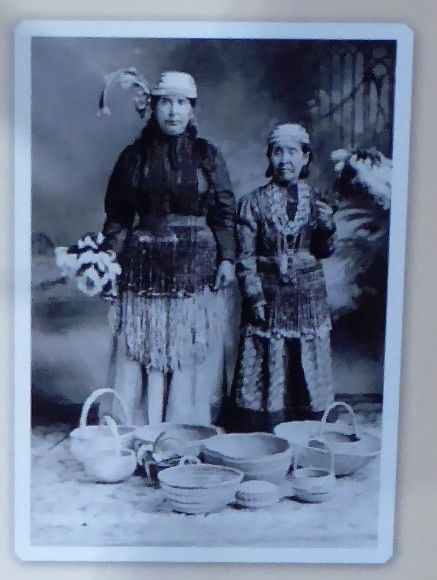The North Lincoln County Historical Museum in Lincoln City, Oregon has two floors of displays relating to local history. The region was originally the homeland for the Siletz and Alesa Indians and the museum has a small display of American Indian basketry.

For thousands of years prior to the European invasion, American Indians occupied the Central Oregon Coast area. In his book The Indians of Yaquina Bay, E.Wayne Courtney writes:
“Since there is no written record, the verification of the presence of humans during prehistoric times has been mainly the responsibility of the work of carbon-dating archeologists. On the Oregon coast, the analyses of shell middens and ancient housepits have been the primary source for getting prehistoric evidence.”
E. Wayne Courtney also explains:
“Middens are really heaps of shell bones and tools which were left by ancient people who camped and worked close to the ocean.”
The Museum display describes the Central Oregon Coast Native Americans this way:
“These relatively peaceful peoples shared a mild climate and plentiful foods obtained through hunting, fishing and harvesting root, nut and berry crops.”

As in other American Indian cultures, the Siletz weavers were women and the art and craft of making baskets was passed from the older weavers to young girls. According to the Museum display:
“Fiber, form and individual finish all assure that each Siletz basket is unique. In addition to this, the symbols used to decorate each work are a traditional concept expressed in visual form, making Indian basketry an art form, not just a craft.”
 Shown above is a Siletz basket made in the 1920s from hazelnut shoots. Judging from the handle, this basket was probably made for the tourist market.
Shown above is a Siletz basket made in the 1920s from hazelnut shoots. Judging from the handle, this basket was probably made for the tourist market.
 Shown above is a Siletz basket.
Shown above is a Siletz basket.
 Shown above is a small Siletz basket made for the tourist market.
Shown above is a small Siletz basket made for the tourist market.
 Shown above are a basket of unknown origin and a Siletz basket made for the tourist trade.
Shown above are a basket of unknown origin and a Siletz basket made for the tourist trade.
 Shown above is a possible Tillamook/Clatsop basket. Lidded baskets of this type were generally made for the tourist market.
Shown above is a possible Tillamook/Clatsop basket. Lidded baskets of this type were generally made for the tourist market.
 Shown above is a possible Tillamook/Clatsop basket
Shown above is a possible Tillamook/Clatsop basket
 Shown above is a possible Tillamook/Clatsop basket made for the tourist trade.
Shown above is a possible Tillamook/Clatsop basket made for the tourist trade.
 Shown above is a Siletz basket with a decorative beaded rim.
Shown above is a Siletz basket with a decorative beaded rim.
 Shown above is a bark container of unknown origin
Shown above is a bark container of unknown origin
 Shown above is a possible Tohono O’odham (Papago) basket from the Southwest
Shown above is a possible Tohono O’odham (Papago) basket from the Southwest
 Shown above is a Klickitat “water basket”
Shown above is a Klickitat “water basket”
 Shown above is a basket hat.
Shown above is a basket hat.
 Shown above is a berry basket.
Shown above is a berry basket.
 Shown above is a old photograph of Siletz weavers displaying their baskets for sale.
Shown above is a old photograph of Siletz weavers displaying their baskets for sale.
 Shown above is a display of weaving techniques.
Shown above is a display of weaving techniques.
Indians 101
More American Indian basketry from this series:
Indians 101: Aleut Basketry (Photo Diary)
Indians 101: California Indian Baskets in the Maryhill Museum (Photo Diary)
Indians 101: Arctic Baskets (Photo Diary)
Indians 101: Klikitat Baskets (Photo Diary)
Indians 101: Pomo Indian Baskets (Photo Diary)
Indians 101: Southwestern Baskets in the Maryhill Museum (Photo Diary)


